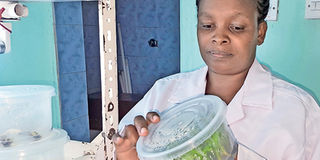How I set up tissue culture laboratory

Ann Kitisya in her banana tissue culture lab in Kitengela. She started her career at the University of Nairobi as a tissue culture technician, dealing with strawberries and flowers. PHOTO | JOSEPH NGUNJIRI | NMG
What you need to know:
- I started my career at the University of Nairobi as a tissue culture technician — dealing with strawberries and flowers. Young and ambitious, I was on the lookout for opportunities to upgrade my career and earnings.
- With my limited financial capacity, I started with the tissue culture bananas. Well, it worked, and demand for the seedlings was huge.
- I sold more shares, bringing in two more investors who facilitated the move to the current premises that hold the initiation, multiplication, and rooting chambers.
- Also in this category is the ever popular sweet banana. The second category is the matoke or cooking banana topped by Kiganda and Ngombe, then the delectable plantain.
In the bustling township of Kitengela, on the outskirts of Nairobi, Ann Kitisya churns out a variety of tissue culture seedlings, which she sells to farmers across the country through her Mimea International Limited. She tells her story to Susan Kabathi
I started my career at the University of Nairobi as a tissue culture technician — dealing with strawberries and flowers. Young and ambitious, I was on the lookout for opportunities to upgrade my career and earnings.
The search did not take long.
My experience and recommendation from the university landed me a job at Genetics Technologies International Limited (GTIL), the first private tissue culture enterprise in the country. Previous ventures had been dominated by universities and Kalro-Thika.
I worked with GTIL for 10 years, honing my skills under demanding and experienced management. This is where I ‘sniffed’ real money in tissue culture after seeing the big opportunity.
I went for a side hustle in 2004, using the most basic equipment for the lab. I put up a ‘kienyeji’ control chamber and used a domestic pressure cooker as an autoclave for sterilising soil samples.
With my limited financial capacity, I started with the tissue culture bananas. Well, it worked, and demand for the seedlings was huge.
I could not behave like the proverbial hyena for long without jeopardising both my job and the budding business, so I followed my instincts, and with my meagre savings and boundless energy, I registered Mimea International Limited.
I then quit employment in 2005. Soon after, the makeshift lab could not contain us, as it was bursting at the seams with plants and all the paraphernalia of the trade.
I realised I needed more specialised hands, a bigger space and better equipment but all this needed money yet the banks could not listen to me.
It was a tough time. A family friend bought shares into the company, affording us the required financial capital that pushed the business to the next level.
GROWN FROM HUMBLE BEGINNINGS
We hired technicians, acquired new equipment, particularly the much-needed laminar flow hood — a controlled air chamber that provides an aseptic environment for the plant cultures from contamination. Then money ran out.
I sold more shares, bringing in two more investors who facilitated the move to the current premises that hold the initiation, multiplication, and rooting chambers.
After the lab process, the banana plantlets are hardened in shade tunnels.
The gestation process, from initiation to the field, takes ten months. We then sell the delicate plantlets to satellite nurseries that harden them further for two months before being released to the farmers.
To grow a healthy, productive crop, a farmer must ensure the shamba has well-drained soils, water to supplement rainfall, and plenty of organic manure.
For me, it has not been necessary to advertise the business. Adherence to fair trade practices and high-quality products has been the best advertisement for us.
The past ten years have been good for the business. Our star crop remains the tissue culture banana, which we classify into ripening varieties like Grand Nain, William Hybrid, and Chinese Cavendish, all popular because of their big bunches and many long fingers.
Also in this category is the ever popular sweet banana. The second category is the matoke or cooking banana topped by Kiganda and Ngombe, then the delectable plantain.
Over the years, the demand for clean seedlings other than bananas has seen Mimea include various fruit and forest trees, sweet potatoes, cutflowers and pyrethrum in its portfolio.
Well, nothing tells the story better than the math. Our annual output of seedlings has grown from humble beginnings to 400,000.
The price per seedling varies between Sh120-Sh150. I can say the sky is the limit but thick clouds of financial stress and dependence on rain-fed agriculture by our farmers limit our progress.




